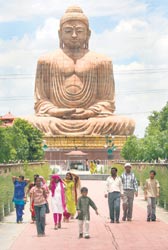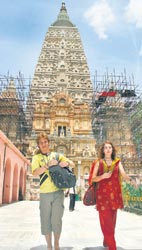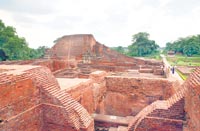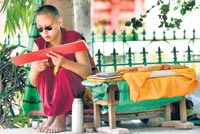|
Bodh Gaya
beckons
Seekers of spiritual nirvana flock
to India's Buddhist heritage
By Nirmala George
BODH GAYA, India (AP) - The road to
Bodh Gaya, one of Buddhism's holiest sites, had been
long and strenuous.
Four hours of jolting along potholed
roads had taken their toll. My back was sore and I was
more in need of spinal therapy than the spiritual therapy
that had brought me to Bihar, a poverty-wracked state
infamous for its appalling crime and lawlessness.
But my all-too human aches fled when
I entered the sprawling silence of the Mahabodhi Temple
complex and let the serenity of the centuries-old shrine
wash over me.
 |
| 80-foot Buddha statue at Bodhgaya. |
There, under the canopy of an ancient
peepul tree, where the rustling of leaves mingled with
the quiet, rhythmic chanting of mantras and the clicking
of prayer beads, sat a group of saffron-robed Buddhist
monks engrossed in prayer.
The elaborately carved Mahabodhi Temple,
Buddhism's holiest shrine and a popular destination
for nirvana seekers, marks the site where the prince-turned-hermit-turned-spiritual-leader,
Gautama Siddhartha, attained enlightenment some 2,500
years ago after intense meditation.
 |
| The Mahabodhi Temple |
From then on, he was known as the Buddha,
or "Enlightened One."
Today, there are an estimated 360
million Buddhists around the globe.
Bihar is a checkerboard of Buddhist
holy sites. A few hours drive from Bodh Gaya is the
town of Rajgir, where the Buddha taught and meditated.
Nearby is Nalanda, one of the world's earliest universities,
which flourished in the 5th century B.C.
The state is also an increasingly
important stop for wealthy tourists, many seeking their
own, luxurious form of enlightenment.
For years, those tourists were largely
people who grew up Buddhist, often in Japan, Thailand
or Sri Lanka. But increasingly, Buddhism's appeal has
spread to the West, where the Buddha's teachings about
nonviolence and spiritualism have been melded with beliefs
ranging from Judaism to atheism.
But Bihar isn't ready-made for wealthy tourists.
While India's economic boom has spurred
economic development in many regions, Bihar has lagged
badly, with a state government nearly paralyzed by corruption
and mismanagement. Tourists are advised to return to
their hotels before dark and to stick to government-licensed
taxis and buses to avoid being -- literally -- taken
for a ride.
So while there are glass-walled shopping
malls outside New Delhi and high-end spa resorts in
India's southern backwaters, much of Bihar struggles
with barely paved roads, on-and-off electricity and
rampant crime.
That has meant that despite its abundance
of Buddhist treasures, the state fails to draw its full
share of tourists.
 |
| Tourists walk along the ruins
of the Nalanda University. |
Not that Bihar isn't trying.
While the state doesn't track religious
tourists, officials say the Buddhist trail is increasingly
hot. After the Mahabodhi Temple was named a World Heritage
site in 2002, Bodh Gaya has seen a steady rise in visitors.
As India's torrid summer gives way to the monsoon rains
and cooler weather in October, they come flocking.
"In the fast-paced lives that
people lead, increasingly -- perhaps instinctively --
there is a trend to discover our inner selves. And most
of the tourists who come here are doing so in search
of that inner peace," said Rama Shankar Tewari,
Bihar's top tourism official.
 |
| A Buddhist monk reads scripts
at the Mahabodhi Temple. |
Tourism authorities are trying to
cash in with an ambitious tourist campaign, "Come
to India: Walk with the Buddha." As part of that,
roads are being repaved, museums are being refurbished
and public restrooms being built or repaired.
Security around the shrines and monasteries
has also been stepped up to ensure that pilgrims are
not hounded too much by touts and beggars. Still, most
sites have their share of children holding out stick-thin
arms and trinket vendors periodically shooed away by
security guards.
A year-long celebration of the 2,550th
anniversary of the Buddha's death, called the Parinirvana,
began in May, but plans to gradually upgrade facilities
will unfold over 25 years.
The detailed blueprint includes numerous
luxury and budget hotels around the Buddhist circuit.
It also includes a world-class 18-hole golf course in
Bodh Gaya and luxurious spas, said Manoj Srivastava,
who heads Bihar's state-run tourism development corporation.
If that seems odd logic - bringing
the hedonism of golf to a land steeped in both spiritualism
and poverty - Srivastava disagrees.
"While Bihar's rich trove of
Buddhist treasures serves the spiritual quest, the average
traveller is also looking to relax," he said.
And despite it all -- despite the
bad roads, the beggars and the trinket-vendors selling
plastic Buddha statues, key chains with imprints of
the Buddha's feet and kitschy bead necklaces -- spiritualism
is everywhere here.
"Everyone warned me against visiting
Bihar. Even after we landed in India, people kept saying:
'Be careful, it's Bihar.' But our experience has been
splendid," said Natalie Halle, a schoolteacher
from Valencia, Spain, visiting Bodh Gaya for the second
time in as many years.
"The serenity about this place
brings you back, and you forget all the warnings,"
she said.
A hush descends on visitors when they
visit the Mahabodhi Temple, which rises from a gently
sloping hollow. White-robed nuns sit cross-legged at
the foot of the enormous carved and gilded Buddha statue,
reading holy verses in a deep sonorous hum.
The temple and the adjoining Mahabodhi
tree, under the shade of which Buddha attained enlightenment,
has long been a pilgrimage destination.
Bodh Gaya is also home to dozens of
monasteries built and maintained by various Buddhist
countries. Thailand's monastery, with its gilded Buddha
statues, brilliantly colored wall paintings and rich
silken wall hangings offers a contrast to the more simplistic
lines of the Japanese temple, or the Himalayan architectural
style of the Tibetan monastery, with its carved dragons,
pennants and archways.
As I set out from Patna as dawn was
breaking one recent morning, the distant purple hills
were shrouded in a hazy mist, the road flanked by a
patchwork of verdant rice fields dotted with ponds and
thatched houses.
My destination was the international
World Peace stupa, a shrine a few kilometres (a couple
of miles) from Rajgir. Access is by an "aerial
rope-way" -- a euphemism for a chain of rickety
bucket chairs strung on a pulley – which takes
you to the top of the hill in seven minutes. Otherwise,
it's an arduous hour-long trek.
Hundreds of visitors line up each
day, many looking more for the rope-way's thrill and
the spectacular views than for some sort of enlightenment.
I had a momentary twinge of fear as
I was pushed into a chair as it slowed down -- barely
-- to pick me up. But it was a smooth ride to the top.
A leisurely stroll brought me to a
sprawling Japanese-built monastery, its wide open doors
producing an air-conditioned effect from the sharp breezes
that blow in.
"The breeze makes you forget
that there's been no power for more than two hours,"
said G. Okonogi, a Japanese monk who has made the remote
monastery his home for over 25 years.
If
you go... |
Getting there:
You can fly directly to the town of Gaya from
New Delhi and Calcutta, as well as from Bangkok,
Thailand and Colombo, Sri Lanka. From the Gaya
airport, take a taxi to Bodh Gaya, 12 kilometres
(7 miles) away, where hotels and monasteries abound.
Patna, the state capital, is served by many
more flights, but is 135 kilometres (85 miles)
away from Bodh Gaya. Hire a taxi for the nearly
four-hour ride from Patna, or take one of the
many tourist buses connecting Patna to Bodh Gaya.
Accommodations:Hotels in Bodh Gaya are cheap
by Western standards, but while there are clean,
efficient places to stay, real luxury is still
a few years away. Room rates range from US$54
to as low as US$4 a night.
When to go: The best time to visit Bihar is between
October and March, unless you are prepared to
endure India's summer heat.
For more information: Web sites about visiting
Buddhist religious sites and monuments include
- http://www.indianholiday.com
- http://www.buddhist-temples.com
- http://www.holidayshub.com
- http://www.overlandescape.com
-
http://www.india-tourism.net
-
http://www.tourisminindia.com
|
| 